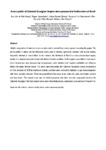Use este identificador para citar ou linkar para este item:
http://www.alice.cnptia.embrapa.br/alice/handle/doc/909890Registro completo de metadados
| Campo DC | Valor | Idioma |
|---|---|---|
| dc.contributor.author | ARAÚJO, A. J. de B. | pt_BR |
| dc.contributor.author | VANDERLINDE, R. | pt_BR |
| dc.contributor.author | OLIVEIRA, J. B. | pt_BR |
| dc.contributor.author | NASCIMENTO, R. L. | pt_BR |
| dc.contributor.author | BIASOTO, A. C. T. | pt_BR |
| dc.contributor.author | PEREIRA, G. E. | pt_BR |
| dc.date.accessioned | 2011-12-15T11:11:11Z | pt_BR |
| dc.date.accessioned | 2011-12-15T11:11:11Z | pt_BR |
| dc.date.available | 2011-12-15T11:11:11Z | pt_BR |
| dc.date.available | 2011-12-15T11:11:11Z | pt_BR |
| dc.date.created | 2011-12-15 | pt_BR |
| dc.date.issued | 2011 | pt_BR |
| dc.identifier.citation | In: CONGRESO LATINOAMERICANO DE VITICULTURA Y ENOLOGIA, 13., 2011, Santiago do Chile. Sustentabilidad y cambio climático: impacto para la industria vitivinícola. Santiago: Asociación Nacional de Ingenieros Agrónomos Enólogos de Chile, 2011. | pt_BR |
| dc.identifier.uri | http://www.alice.cnptia.embrapa.br/alice/handle/doc/909890 | pt_BR |
| dc.description | Volatile composition of wines is a very complex and is derived from many sources, including the grape. The aroma profile in wines can be influenced mainly due to climatic, agronomic practices and human factors, frequently referred as terroir effect. In this context, the Northeast of Brazil is a new vitivinicultural region, located in a tropical semi-arid climate with distinct climatic condition. In this region is possible to have two or three harvests per year, because high temperatures, solar radiation and irrigation availability can influence highest the grape derived aroma. The wines were elaborated with Cabernet Sauvignon grapes harvested in the first semester of 2009 by traditional method, and then were analyzed in triplicate by gas chromatography with flame ionization detector. There were quantified in the wines seven carboxylic acids, four higher alcohols and nine esters. The majority ester was the diethyl succinate and other aromatic compounds found in the Cabernet Sauvignon Brazilian tropical wines were ethyl dodecanoate, isobutanoic acid and trans-3-hexen-1-ol. | eng |
| dc.format | 1 CD-ROM. | pt_BR |
| dc.language.iso | eng | pt_BR |
| dc.rights | openAccess | pt_BR |
| dc.subject | Variabilidade climática | pt_BR |
| dc.subject | Vinho tropical | pt_BR |
| dc.subject | Compostos voláteis | pt_BR |
| dc.subject | Ttipicidade | pt_BR |
| dc.title | Aroma profile of Cabernet Sauvignon tropical wines produced in Northeastern of Brazil. | pt_BR |
| dc.type | Resumo em anais e proceedings | pt_BR |
| dc.date.updated | 2015-04-10T11:11:11Z | pt_BR |
| dc.subject.thesagro | Uva | pt_BR |
| dc.subject.thesagro | Vitis Vinifera | pt_BR |
| dc.subject.nalthesaurus | Grapes | pt_BR |
| dc.subject.nalthesaurus | Volatile compounds | eng |
| dc.subject.nalthesaurus | Wines | eng |
| riaa.ainfo.id | 909890 | pt_BR |
| riaa.ainfo.lastupdate | 2015-04-10 | pt_BR |
| dc.contributor.institution | ANA JULIA DE BRITO ARAUJO | pt_BR |
| dc.contributor.institution | REGINA VANDERLINDE | eng |
| dc.contributor.institution | JULIANE BARRETO OLIVEIRA | eng |
| dc.contributor.institution | RUSSAIKA LÍRIO NASCIMENTO | eng |
| dc.contributor.institution | ALINE CAMARAO TELLES BIASOTO, CPATSA | eng |
| dc.contributor.institution | GIULIANO ELIAS PEREIRA, CNPUV / CPATSA. | eng |
| Aparece nas coleções: | Resumo em anais de congresso (CPATSA)  | |
Arquivos associados a este item:
| Arquivo | Descrição | Tamanho | Formato | |
|---|---|---|---|---|
| Giuliano42011.pdf | 49,58 kB | Adobe PDF |  Visualizar/Abrir |









